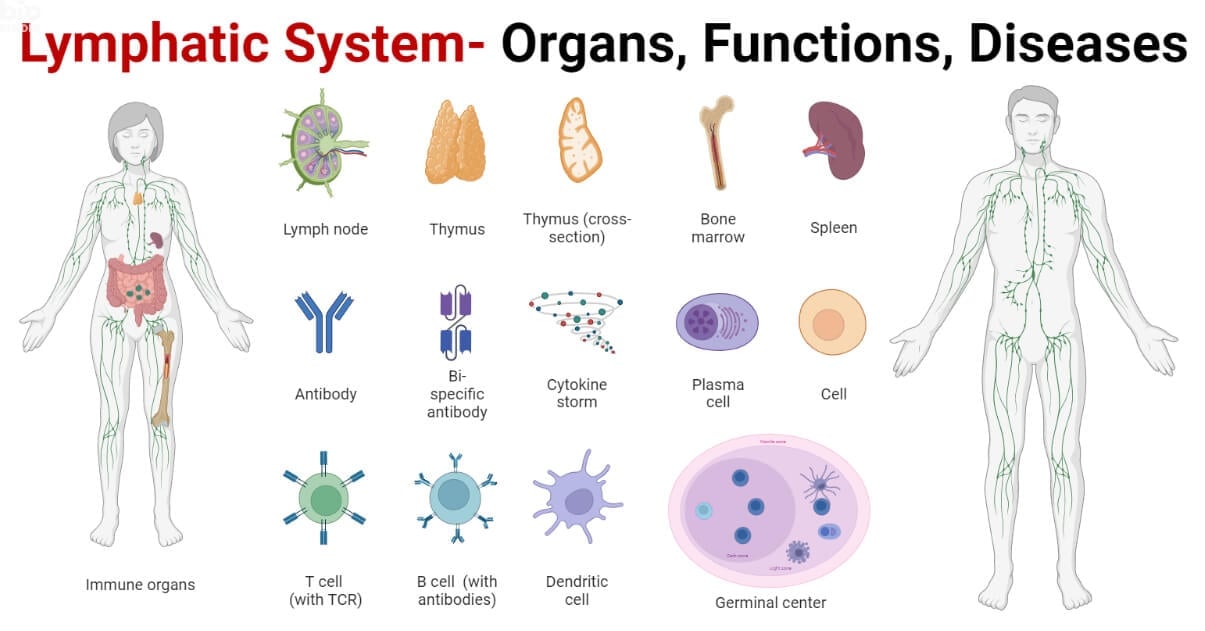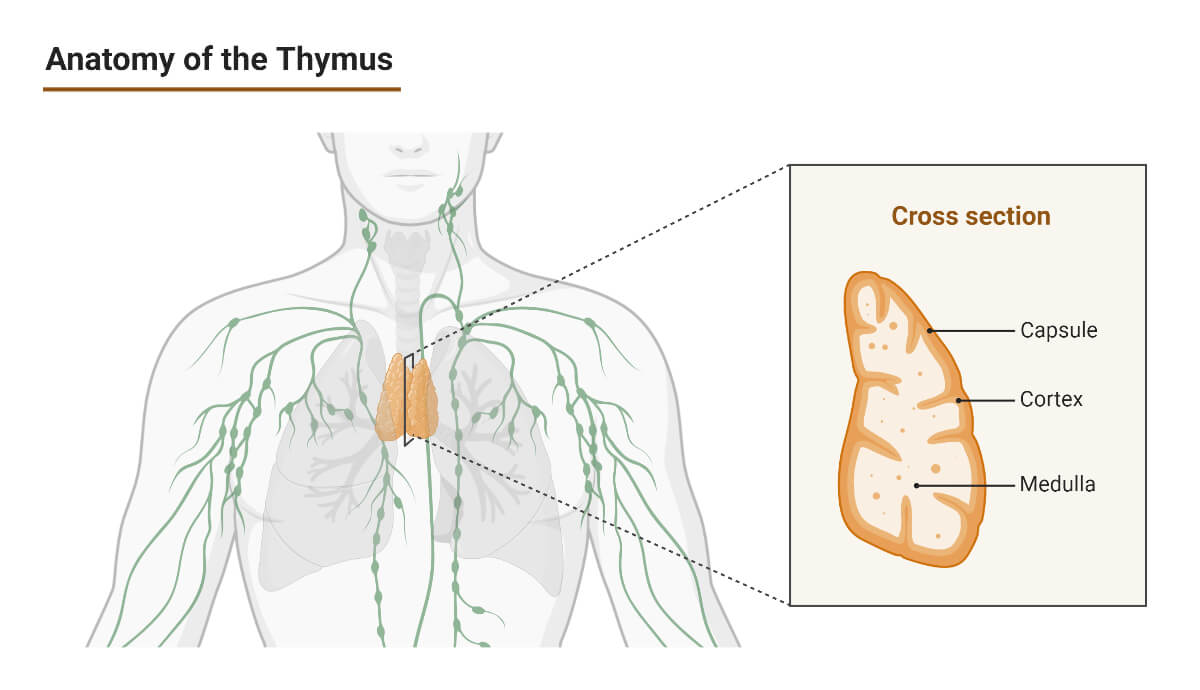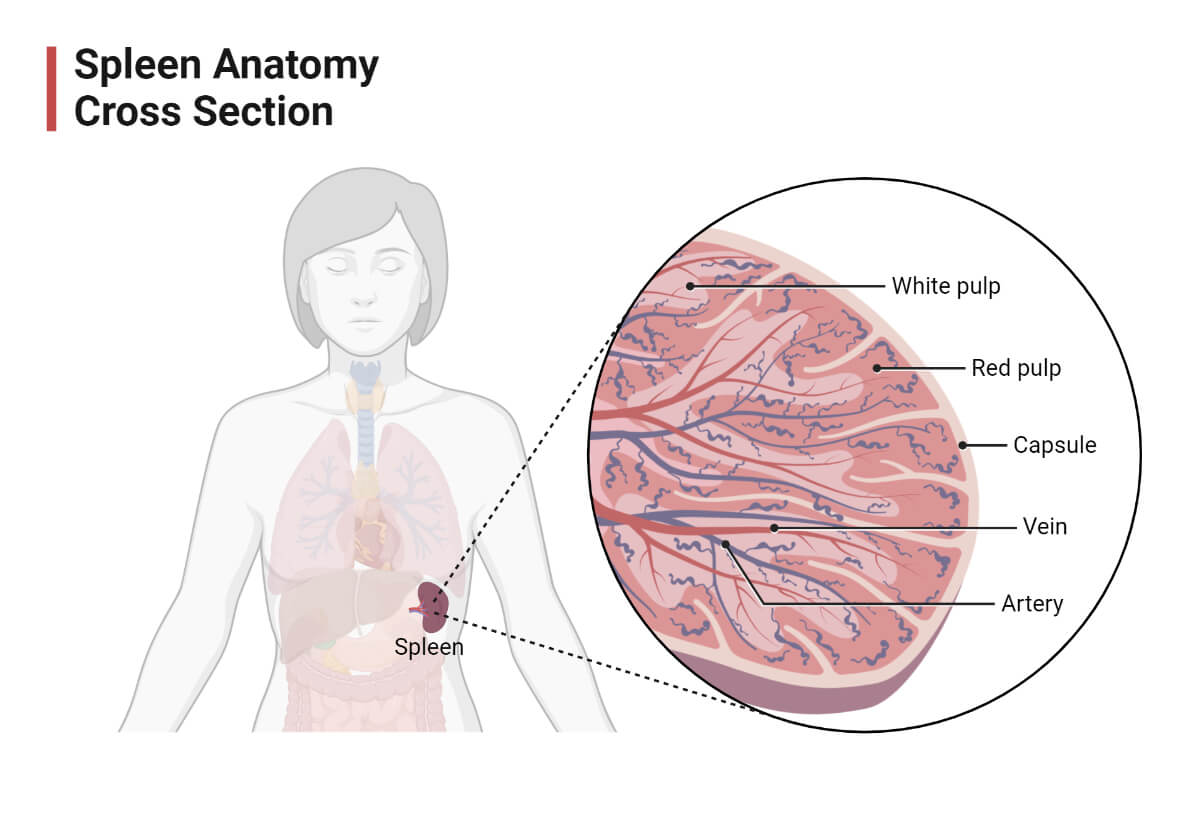The lymphatic system is an organ system in vertebrates that helps collect (excess interstitial fluid) lymph from tissues and the transportation of the fluid back to the bloodstream for re-circulation.

Lymphatic System is composed of lymphoid organs, lymph nodes, lymphatic vessels, and lymph.
The lymphatic system is a part of the circulatory system as well as a part of the immune system. It collects the excess body fluid and returns it to the venous circulation so; it is a part of the circulatory system. Similarly, it circulates lymphocytes and plays a key role in lymphocytes-mediated (adaptive) immunity; therefore, it is a part of the immune system.
Interesting Science Videos
Organs of the Lymphatic System
Anatomically, the lymphatic system is made up of two structures; the lymphoid tissues/organs, and the lymphatic vessels.
1. Lymphoid Tissues/Organs
It comprises organs and specialized tissues that produce and maintains lymphocytes and/or collect lymph and connect it to the bloodstream. The lymphoid organ system can be categorized into primary and secondary lymphoid organs.
a. Primary Lymphoid Organs
It includes lymphoid organs where the lymphocytes are produced, maintained, and matured. It includes:
Thymus
The thymus is a primary lymphoid organ where T-lymphocytes are matured and undergo the process of positive and negative selection. It is located in the throat in front of the heart, just behind the sternum in the anterior portion of the mediastinum.

The thymus is functional and distinctly visible up to the early teen (pre-adolescent) age and gradually degenerates and is finally replaced by fat. Hence, it is not found in an adult humans.
Structurally, it is a bilobed organ of about 4 to 6 cm by 2.5 to 5 cm by 1 cm in dimension having a mass of about 50 grams. Each lobe is made of two regions; the outer cortex and the inner medulla. The cortex is made of immature T cells called thymocytes supported by epithelial cells, blood vessels, and other leukocytes. The medulla is mainly made of epithelial cells in form of Hassall’s corpuscles.
In the cortex, thymocytes mature into T cells and undergo a selection process to eliminate the T-cells that can target the body’s own components. The selected T cells are passed to the medulla where they undergo further maturation and differentiation.
Bone Marrow
Bone marrow is a special semi-solid tissue mass composed primarily of hematopoietic stem cells, adipose tissue, and stromal cells that is present inside the bone in the cancellous section. The red bone marrow is a primary organ of a lymphoid system whose main function is to produce B lymphocytes.
Fetal Liver
In the fetus stage, the liver cells produce lymphocytes; hence, the fetus’s liver is a primary organ of the fetal lymphatic system. However, the liver of infants and adults does not produce any lymphocytes.
b. Secondary Lymphoid Organs
It includes lymphoid organs where the lymphocytes undergo further maturation and contact the bloodstream with the lymph. It includes:
Spleen
The spleen is the blood filter of vertebrates found at the back of the stomach in the abdominal cavity below the diaphragm. It is a large organ or about 13 cm by 8 cm by 3 cm in dimension and weighs about 200 grams.

Anatomically, it contains two distinct types of tissues; the red pulp and the white pulp. The red pulp plays the primary function of filtering the blood, removing the old RBCs, and digesting the hemoglobin. The white pulp primarily contains lymphocytes (both B and T lymphocytes). It is a site where lymphocytes are activated by the antigens present in the blood resulting in the activation of the humoral and cell-mediated immune response.
Lymph Nodes
Lymph nodes are encapsulated small kidney-shaped mass of lymphatic tissues distributed throughout the body along the network of lymphatic vessels which filters the lymph and stores lymphocytes. They are numerous (more than 600 in an adult human) small nodes of varied sizes ranging from 2 to 25 mm in length. They are prevalent in the armpits (Called the axillary lymph nodes), groins (called the inguinal lymph nodes), neck (called the cervical lymph nodes), and knees (called the popliteal lymph nodes). Anatomically, the lymph node is divided into two regions; the inner medulla and the outer cortex externally covered by a fibrous capsule. Each lymph node is connected with multiple afferent lymphatic vessels in its convex side from where lymph enters the node. On the concave side, there is an efferent lymphatic vessel from where filtered lymph leaves the node.

The lymph nodes filter the lymph and identify antigens or pathogens present in the circulation and activate the cell-mediated immune responses if any foreign bodies are detected. They harbor lymphocytes and regularly pass them into blood circulation for immune surveillance and response.
Mucosa-associated Lymphatic Tissues
These include diverse types of lymphoid tissue masses present in the mucosal surface of several organs. They are primarily located in organs and mucosal surfaces of the gastrointestinal, respiratory, and genitourinary systems. The major types of mucosa-associated lymphatic tissues are found in tonsils and Payer’s patches.
c. Tertiary Lymphoid Organs
These are abnormal lymphoid tissues and nodes that form during chronic infections, cancer and tumor growth, organ transplantation, an autoimmune condition, and other abnormal body conditions.
2. Lymphatic Vessels
Lymphatic vessels also called lymph vessels or lymphatics, are the closed thin-walled tubes that form a network of ducts interconnecting the lymphoid organs through which lymph circulates. Structurally they can be classified as smaller lymph capillaries where the interstitial fluid (lymph) enters the vessel, and larger collecting lymph vessels formed by converging of several lymph capillaries which circulate the lymph. Lymph vessels are one-way vessels that collect and transport lymph from body tissues to the heart. There are several lymphatic mini-valves that check the backflow of lymph and maintain the unidirectional flow of lymph.
Lymph
Lymph is a clear, yellow-colored extra interstitial fluid. It is similar to highly filtered plasma in composition with fewer plasma proteins and abundant leukocytes (lymphocytes and macrophages). It is primarily the plasma that was originally transported via blood circulation in order to deliver nutrients and other components to body cells. This transported plasma gets filtered and is passed out of cells as an interstitial fluid which is then collected by the lymph capillaries and circulated in the lymphatic system as lymph. It is primarily composed of water (about 95% water) and the rest is plasma proteins, glucose fatty acids and fats, ions, lymphocytes, macrophages, and other trace elements. Its main function is the transportation of nutrients, lymphocytes, antibodies, metabolic wastes, and cellular debris, and the promotion of intercellular communication.
Lymphoid Circulation
Lymph circulates through the lymphatic vessels. Lymph circulation is a unidirectional process i.e. unlike blood circulation lymph only circulates from body tissues to the heart. Similarly, there is no pumping organ like a heart for powering lymph circulation. The pressure exerted by the excess of the interstitial fluid forces the fluid to enter the lymph capillaries. The pressure generated by the smooth muscle contraction of lymphatics and the movement of organs and tissues forces the movement of lymph inside the lymph vessels. There are several valves to prevent the backflow of the lymph.
The pathway of circulation of lymph is from interstitial fluid to lymphatic capillaries to afferent lymph vessels to lymph nodes to efferent lymph vessels to lymphatic trunks to collecting duct to the subclavian vein which finally returns the fluid into the bloodstream.

Functions of the Lymphatic System
- Collects and removes the extra interstitial fluid and returns it to the bloodstream for recirculation. This maintains the fluid level in the body. Hence, it is also called the drainage system of vertebrates.
- It plays a major role in humoral and cell-mediated immunity. It proliferates, differentiates, stores, and circulates lymphocytes.
- Lymph nodes are the sites where antigens are presented with lymphocytes for activation of immune response and production of functional antibodies.
- Lymphatics also transport fatty acids and fats.
- Helps in the transportation of debris, wastes, and abnormal cells.
Diseases Associated With Lymphatic System
- DiGeorge Syndrome: It is a congenital disorder caused due to microdeletion of a section (22q11.2 gene) of chromosome 22. This results in poor development of the thymus and tonsils of the lymphatic system and several other organs.
- Nezelof Syndrome: It is a congenital disorder with an autosomal recessive inheritance that results in atrophy of the thymus without any other congenital abnormalities.
- Lymphedema: It is a lymphoid disorder characterized by swelling of body tissue due to over-accumulation of lymph. Blockage of normal lymph flow usually results in lymphedema.
- Lymphoma: It is a cancer of the lymphatic system and can be defined as cancer that begins in the lymphatic system. There are two major types of lymphoma; Hodgkin lymphoma (lymphoma that spreads in an orderly fashion from one lymph node to another), and Non-Hodgkin (lymphoma that spreads randomly in a non-orderly fashion from one lymph node to another).
- Lymphatic filariasis: Also called Elephantitis, is the blockage of lymphatic circulation by parasitic nematodes. The primary pathogen is Wuchereria bancrofti which is accountable for more than 90% of the infection. Besides, Brugia malayi and B. timori is also associated with other 10% of filariasis. It is a mosquito-borne disease transmitted by the Aedes aegyptis mosquito.
- Lymphadenopathy: It is the swelling of lymph nodes.
- Lymphadenitis: It is the infection of lymph nodes generally by bacteria, fungi, and/or viruses resulting in lymphadenopathy.
- Lymphangitis: It is the inflammation (swelling) of lymphatic vessels and organs due to infections by bacteria, fungi, and/or viruses. It is different from lymphadenitis in the fact that in lymphangitis there is swelling of vessels and organs not only the swelling of lymph nodes.
- Lymphocytosis: It means an increase in the lymphocyte count.
- Castleman Disease: It is a rare disorder of the lymphatic system characterized by enlargement of lymph nodes.
- Lymphangioma: It is a rare congenital condition that results in the formation of fluid-filled sacs across the lymphatic vessels. It usually occurs in the head, neck, and mouth but can be formed all over the body beneath the skin.
- Lymphangioleiomyomatosis: It is the abnormal proliferation of smooth muscle cells in lymphatic vessels of the lungs resulting in the formation of cysts or holes in the lungs. It primarily affects women 20 to 40 years of age.
- Lymphoproliferative Syndrome: It is a rare genetic disorder characterized by uncontrolled non-malignant proliferation of lymphocytes.
- Tonsilitis: It is the swelling of tonsils usually caused by viral and bacterial infection of the tonsils.
References
- Ross & Wilson Anatomy & Physiology in Health and Illness. 13th ed. Churchill Livingstone Elsevier. ISBN 978-0-7020-7276-5
- Goswami, A. K., Khaja, M. S., Downing, T., Kokabi, N., Saad, W. E., & Majdalany, B. S. (2020). Lymphatic Interventions: Lymphatic Anatomy and Physiology. Seminars in Interventional Radiology, 37(3), 227-236. https://doi.org/10.1055/s-0040-1713440
- Britannica, The Editors of Encyclopaedia. “lymphatic system”. Encyclopedia Britannica, 12 Dec. 2022, https://www.britannica.com/science/lymphatic-system. Accessed 21 January 2023.
- Lymphatic system. (2023, January 15). In Wikipedia. https://en.wikipedia.org/wiki/Lymphatic_system
- Reddy NP. Lymph circulation: physiology, pharmacology, and biomechanics. Crit Rev Biomed Eng. 1986;14(1):45-91. PMID: 3524994.
- Lymphatic System Anatomy and Physiology – Nurseslabs
- Lymphatic system: Definition, anatomy, functions | Kenhub
- Lymphatic System: Diagram, Function, Anatomy, Diseases (verywellhealth.com)
- Lymph. (2023, January 2). In Wikipedia. https://en.wikipedia.org/wiki/Lymph
- Lymphatic System: Parts & Common Problems (clevelandclinic.org)
- Lymphatic system: Definition, anatomy, function, and diseases (medicalnewstoday.com)
- Lymphatic System – Definition, Function, Structure | Biology Dictionary
- Lymphatic system – Better Health Channel
- Lymphatic System: Definition, Anatomy, Components, Functions – Embibe
- Lymphatic system: Facts, functions & diseases | Live Science
- What is Lymphatic System? What are lymph nodes & Lymphocytes (lymphoma.ca)
- What Is Lymph? – The Important Function and Composition of Lymph in Humans (byjus.com)
- Lymph | definition of lymph by Medical dictionary (thefreedictionary.com)
- Lymph – Definition, Components and Examples | Biology Dictionary
- Lymph circulation | definition of lymph circulation by Medical dictionary (thefreedictionary.com)
- Lymphatic System- Introduction, Structure, Circulation, Organ and FAQs (vedantu.com)
- Circulation of Lymph with Flow Chart (byjus.com)
- How is Lymph Formed and Transported – Lymph Circulation Flow Chart » AnatomyLearner >> The Place to Learn Veterinary Anatomy Online
- Lackey AE, Muzio MR. DiGeorge Syndrome. [Updated 2022 Aug 8]. In: StatPearls [Internet]. Treasure Island (FL): StatPearls Publishing; 2022 Jan-. Available from: https://www.ncbi.nlm.nih.gov/books/NBK549798/
- DiGeorge syndrome (22q11.2 deletion syndrome) – Symptoms and causes – Mayo Clinic
- Nezelof syndrome (Concept Id: C0152094) – MedGen – NCBI (nih.gov)
- Lymphedema: Symptoms, Causes & Treatment (clevelandclinic.org)
- Lymphoedema – NHS (www.nhs.uk)
- Lymphoma | CDC
- Lymphoma: Definition, Symptoms, Causes, Diagnosis, Treatment (webmd.com)
- Lymphoma – symptoms, causes, treatment & side effects | healthdirect
- Lymphatic filariasis (who.int)
- CDC – Lymphatic Filariasis
- Lymphadenitis | Johns Hopkins Medicine
- Swollen lymph nodes – Symptoms and causes – Mayo Clinic
- Lymphangitis: Causes, symptoms, and pictures (medicalnewstoday.com)
- Lymphangitis: Definition, Causes, Symptoms, and Treatment (webmd.com)
- Lymphangitis: Causes, Symptoms, and Diagnosis (healthline.com)
- Lymphocytosis (high lymphocyte count) Causes – Mayo Clinic
- Castleman Disease: Types, Causes, Symptoms, Diagnosis, and Treatment (webmd.com)
- Ehsan N, Zahra F. Castleman Disease. [Updated 2022 Nov 14]. In: StatPearls [Internet]. Treasure Island (FL): StatPearls Publishing; 2022 Jan-. Available from: https://www.ncbi.nlm.nih.gov/books/NBK576394/
- Castleman Disease: Types, Symptoms & Treatment (clevelandclinic.org)
- Lymphangioma: Symptoms, Outlook, Treatment, and More (healthline.com)
- Lymphangioma, Lymphatic Malformations Causes & Pictures (clevelandclinic.org)
- Miceli A, Stewart KM. Lymphangioma. [Updated 2022 Aug 8]. In: StatPearls [Internet]. Treasure Island (FL): StatPearls Publishing; 2022 Jan-. Available from: https://www.ncbi.nlm.nih.gov/books/NBK470333/
- Miceli A, Stewart KM. Lymphangioma. 2022 Aug 8. In: StatPearls [Internet]. Treasure Island (FL): StatPearls Publishing; 2022 Jan–. PMID: 29261940.
- Lymphangioleiomyomatosis: Symptoms, Causes, Treatments (clevelandclinic.org)
- Lymphangioleiomyomatosis – About the Disease – Genetic and Rare Diseases Information Center (nih.gov)
- Lymphangioleiomyomatosis: MedlinePlus Genetics
- Tonsillitis – NHS (www.nhs.uk)
- Tonsillitis: Symptoms, Causes, Treatments, Surgery, and Remedies (webmd.com)
- Bleesing JJH, Nagaraj CB, Zhang K. Autoimmune Lymphoproliferative Syndrome. 2006 Sep 14 [Updated 2017 Aug 24]. In: Adam MP, Everman DB, Mirzaa GM, et al., editors. GeneReviews® [Internet]. Seattle (WA): University of Washington, Seattle; 1993-2023. Available from: https://www.ncbi.nlm.nih.gov/books/NBK1108/
- Autoimmune Lymphoproliferative Syndrome (ALPS) | NIH: National Institute of Allergy and Infectious Diseases
- Autoimmune lymphoproliferative syndrome – About the Disease – Genetic and Rare Diseases Information Center (nih.gov)

I’m a 26 yr breast cancer survivor that has metastisized .Now it’s in my lymph nodes in my back. I only went up to 12th grade but I’m trying my darndest to take a more whollistic approach like thumping my thymus,eating non inflammatory, supplements,teas,mushrooms ,herbs,dry brushing .I choose to take long breaks between treatments. Loved your diagrams and explanations that were clear to me THANK YOU